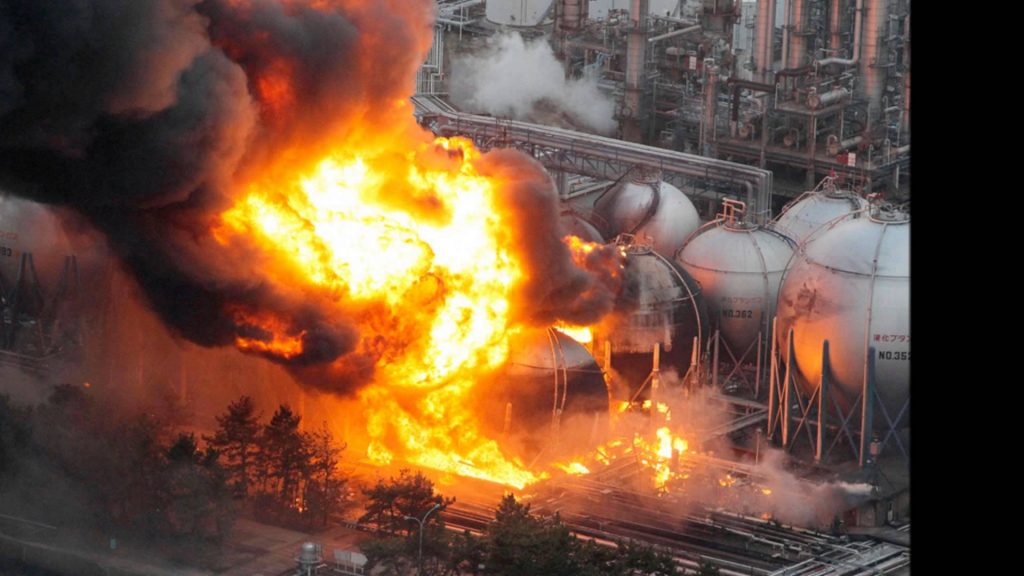Natural disasters are very common but tragic events around the world. From earthquakes to tornadoes, geological disasters can cause increasingly damaging effects, affecting the landscape and those who find themselves there. But when these events are combined with man-made artifacts, the effects might be even greater. An example of this is the Fukushima Disaster in Japan, the worst nuclear disaster since the 1986 Chernobyl incident.1 But the cause of this horrific disaster wasn’t particularly a man-made event. In fact, it all started with a wave.

On March 11, 2011, an earthquake with a magnitude 9.0—the worst to ever hit Japan—hit the country. It was such a powerful catastrophe, that Japan’s main island, Honshu, was permanently moved more than two meters to the east. As the earthquake gained momentum, waves up to 40 meters began crushing the country’s coast. The effects of the earthquake and the waves were too much for the Japanese. More than 20,000 people died or went missing and hundreds of thousands more lost their homes.2 But the worst was yet to come. Fifty minutes after the initial earthquake, a ten-meter high sea wall hit the Fukushima Daiichi (Number One) nuclear power plant. The water flooded the plant’s emergency power generators, knocking vital cooling systems offline, triggering a meltdown of reactor fuel rods. These then leaked deadly radiation into the coastal atmosphere of Japan. With the cooling systems not working, hydrogen gas built up in the reactor buildings, causing several hydrogen explosions in the following days of the earthquake.3

Because of the highly toxic radioactive material that leaked to the surrounding areas of the power plant, the government began to evacuate 80,000 people from a twelve-mile radius. Technicians turned to several things to try to cool the nuclear fuel, like using fresh water, seawater, and injecting nitrogen into the reactor containment buildings to prevent further explosions.4 But despite the efforts to try to help the people of Honshu, the government didn’t tell the people the truth. The official statistics of the event and even the admittance that the meltdown had taken place weren’t disclosed until eighty-eight days later.5
It was estimated that more than 800,000 tons of highly-radioactive material sat near the accident, which was slowly getting into the ground and moving towards the ocean. Although many people were evacuated, there were still many that couldn’t leave. The government installed temporary housing that was intended to house tens of thousands of people after the disaster for twenty-four months. But five years after the disaster, thousands of people were still living where they were surrounded by the radioactive material. Many of those who remained were the elderly and low-income families who had few options to move away.6

Several months after the disaster, people in other parts of Japan began rallying to help these people and bring an end to nuclear power plants in Japan. This pushed forward for the closure of all of the other nuclear plants in Japan for maintenance and inspection.7 These protests also pressured the government to issue a report on the disaster at Fukushima. This report criticized TEPCO (the Tokyo Electric and Power Company) for failing to address concerns about safeguards at the plant. This report also included information about how TEPCO officials had ignored engineers’ concerns that a seawall constructed to protect against major tsunamis as they had seen on March 11 was not sufficient. The report additionally criticized safety regulators for not implementing proper safety measures and for failing to adopt global nuclear safety standards.8 This was really important for the Japanese because TEPCO had always emphasized that the nuclear generators were “fail-safe,” that the facility was completely earthquake resistant and that the reactors would be able to withstand a major tremor.9
Five years after the disaster in Japan, several policies were changed to address the rising concerns of the Japanese population regarding nuclear power plants. The major decision of this kind was the decision to phase-out nuclear power plants during the 2030s as part of Innovative Strategy for Energy and the Environment adopted by the cabinet of the Democratic Party of Japan (DPJ).10 TEPCO is still facing criticism regarding the amount of nuclear material that was leaked into the environment and it is estimated that cleanup operations could take up to forty years.11
- Will Ripley, Junko Ogura, and James Griffiths, “Fukushima: Five Years after Japan’s Worst Nuclear Disaster,” CNN, March 11, 2016, sec. World. ↵
- Encyclopedia Britannica, 2018, s.v. “Fukushima Accident.” ↵
- New World Encyclopedia, 2017, s.v. “Fukushima nuclear disaster.” ↵
- New World Encyclopedia, 2017, s.v. “Fukushima nuclear disaster.” ↵
- Will Ripley, Junko Ogura, and James Griffiths, “Fukushima: Five Years after Japan’s Worst Nuclear Disaster,” CNN, March 11, 2016, sec. World. ↵
- Will Ripley, Junko Ogura, and James Griffiths, “Fukushima: Five Years after Japan’s Worst Nuclear Disaster,” CNN, March 11, 2016, sec. World. ↵
- New World Encyclopedia, 2017, s.v. “Fukushima nuclear disaster,” ↵
- Encyclopedia Britannica, 2018, s.v. “Fukushima Accident.” ↵
- Akira Nakamura and Masao Kikuchi. “What We Know, and What We Have Not Yet Learned: Triple Disasters and the Fukushima Nuclear Fiasco in Japan,” Public Administration Review 71, no. 6 (2011): 894. ↵
- Rie Watanabe, “After the Fukushima Disaster: Japan’s Nuclear Policy Change from 2011 to 2012,” Review Of Policy Research 33, no. 6 (2016): 623. ↵
- Alexis Dudden, “The Ongoing Disaster,” The Journal of Asian Studies 71, no. 2 (2012): 349. ↵




111 comments
Adam Portillo
I remember seeing this in the news at a younger age and felt devastated for Japan and it’s people. I always had knowledge about the earthquake but never heard anything of the nuclear power plants until now. It was sad to see the country get hit by a tsunami and then as a result they got a double whammy with the Power plant also. I had no idea that the main island moved a couple meters east. It’s sad to see that the clean up effort will be a long one and I’m sure that the country is taking more precaution then ever now. Great article that goes into detail on the Fukushima disaster.
Andrea Cabrera
I feel there could be another alternative way of handling the meltdown. Hopefully in the future technology and resources will be enhanced enough to address such an unexpected tragic problem. It’s sad that it had to come until this point for governments to realize that nuclear bombs are no joke. The article was nice at describing vividly and it made you feel like you were there.
Luke Lopez
This was a very informative article on the Fukushima Disaster in 2011. It is sad that Japan was hit with a 9.0 magnitude earthquake, and then right after that the nuclear power plant began to leak radiation as a result of a ten-meter high sea wall that hit the nuclear power plant. The Japanese government should have told their citizens sooner about the nuclear meltdown, and how much radiation was leaked.
Mia Stahl
This summer I had a Japanese exchange student stay with me for two weeks. I learned so much about the culture and the people and a lot about his family and the way he was raised. Having felt so connected with the culture, even from so far away, I have recently been really curious about the events that happened surrounding Fukushima. It seems that not only the power plant but the government could have done much more in the way of handling the meltdown. It is speculated whether everything that could’ve been done was done or in much of the aftermath could’ve been better-taken care of. What happened in Fukushima was tragic and unexpected and hopefully in the future technology and resources will be heightened in order to address such problem.
Mariana Valadez
I had never heard about this incident before reading this article. It was very well written and let me picture this terrible disaster vividly. It is terrifying to realize that our planet can create such disasters. It is scary to think that Japan could have been done until 2030 removing all of the nuclear power. It took an explosion for people to realize that nuclear power plants are not such a good idea.
Diego Aguilera
Anything nuclear is very dangerous and in fact this article displayed that and much more imagery regarding the effects and the heartbreaking tragedy. I really enjoyed this article as it made me feel like I was there. What has me thinking is the plan to clean up and how to deal with all the casualties. The first thing that came to my mind when I read this article was Chernobyl.
Megan Copeland
Reading about this devastating natural disaster made me so sad for the people that had to go through this. It’s crazy that a tsunami could first cause so much damage on its own, but that it can cause other disasters as well. Many people were against the nuclear power plant, but it took it exploding for everyone to realize how bad they really were.
Madeline Torres
This article was in fact written very well and the details in the article helped to imagine how horrible the incident was. I never knew that the government did in fact help house thousands and I had no idea that so many stayed after the incident as well. It’s so scary to think that our own planet can create such disasters. Overall, I thought this article was very well thought out and I loved the information provided.
Janelle Larios
I had heard about the nuclear power plant leak in Cherybol but I had never heard of this. What really shocked me was the fact that Japan is not only trying to completely get rid of Nuclear power plants but that it would most likely be done in the 2030s. Also that because of the leak, it would take almost forty years to clean up and that they’re are still people living near the power plant. The fact that they couldn’t get away is really disheartening in every way. Although I do give props to Japan for trying to abolish nuclear power plants and for taking responsibility for their ignorance and mistakes.
Lamont Traylor
I still remember when that tsunami hit japan and I kept thinking wow this is very bad, it couldn’t get any worse right? Then that’s when they started talking about how the tsunami caused issues in the power plants and how it was going to have long lasting consequences of radiation like Chernobyl. It’s unbelievable to think that 40-meter waves hit Japan and hit it so hard the one of the islands moved 3 meters.